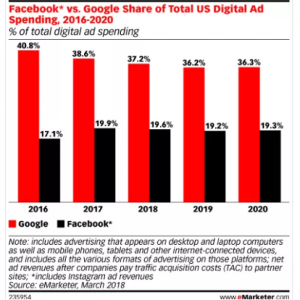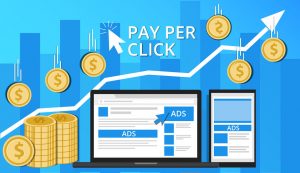There is no arguing the influence that Google and Facebook have on the greater marketing landscape. Over 55% of all marketing dollars make their way to one of these behemoths every year.
Given the market share and overall influence that these two networks enjoy in the marketing space, we wanted to discuss how our agency uses each network to help our clients reach their marketing goals. With a spend of 6 figures per month across each network, our team has a lot of experience taking advantage of the unique opportunities that each network has to offer.
Google is primarily known for its search marketing capabilities. However, it has rapidly expanded into display and YouTube advertising as well. Facebook is known for its social media network which has grown to include Instagram as well. Across each channel there are benefits and limitations. As an example, Google can target based on specific online searches. This can be a powerful marketing opportunity as someone who is actively looking for specific information will be in the mindset to act quickly. Facebook collects a significant amount of information about their user base. This allows marketers to reach audiences based on demographics, interests and behaviors which also lends itself to a powerful tool in a marketer’s arsenal. Throughout this article, we will touch on the benefits and limitations of each as well as how our team has found success across each network.
Google Search
There are three key things to remember when setting up a Google search campaign: volume, relevancy, and competition. When developing a list of search terms we look for the following:
- Volume – Keywords that have a decent number of searches per month (typically 50 searches/month or higher)
- Relevancy – Search terms that are highly relevant to our website and messaging are key to ensuring that we are developing a successful campaign
- Competition – Ensuring that there isn’t so much competition that keyword bidding is prohibitively expensive is important in developing any successful campaign.
Why are these three areas so important?
In terms of volume, around 20% of your search terms will account for 80% of your search traffic. By focusing on high volume search terms, you can better optimize campaigns while focusing on the searches that will have the biggest impact.
Relevancy is a key factor across the entire campaign. By ensuring that search terms are relevant to both your messaging and your website, you will increase both your click through rates and the time visitors spend on your time. This is important because increasing your click through rates will decrease the cost of traffic. This is because the search engines allowing advertising on a cost per click basis. This means that you only spend advertising dollars when someone clicks on your ad. Think of it like this:
Advertiser 1 bids $100 cost per click for an ad that generates 0 clicks for every 100 visitors. The search engine in turn makes $0 for every 100 visitors that are shown these ads ($100 x 0 visits = $0).
Advertiser 2 bids $1 cost per click for an ad that generates 10 clicks for every 100 visitors. The search engine in turn makes $10 for every 100 visitors that are shown these ads ($1 x 10 visits = $10).
In this scenario, Google will prefer to prioritize advertiser 2 over advertiser 1 although they are willing to spend only 1% as much to get in front of the same searchers. And this is why relevancy matters so much.
Finally, competition matters because it directly impacts costs and the likelihood that you will be able to generate relevant clicks to maintain a high click through rate. If your budget is $500/month and you choose to compete on a slate of competitive terms that average a $50 cost per click, then you will only generate 10 clicks per month. The likelihood that these 10 visitors will make an impact on your organization is very slim as volume matters. Therefore, going after less competitive keywords will make a big difference in both the costs to gain visibility and the volume of relevant visitors that you acquire as a result. Therefore, we recommend focusing on what is called long-tail terms as opposed to short tail. These are essentially terms that are 3 – 6 keywords in length and therefore, more specific while drawing in less competition whereas short tail tends to be broad. For example, if you run a law practice, searches for “law practice” will be competitive and expensive. But searches for “collaborative divorce lawyers in Seattle” will be much more specific, cost effective and someone searching for this term is likely to find your firm very relevant if you are in fact a collaborative divorce lawyer.
Keeping these recommendations in mind, we highly recommend all initial research start directly with the Google Keyword Tool: https://ads.google.com/home/tools/keyword-planner/. And with that, here’s an overview of Google 101 directly from one of our star account managers:
What is it?
A digital tactic based around keyword searches on the Google Search Engine.
How does it work?
Ads are shown to users in a specific geographic area, defined during the planning phase, when they search for a term that matches one from our pre-determined list. Keyword lists can contain as many as 500 keywords but should be within the range of 30 – 60 terms to allow us to best monitor and optimize the list.
We can create both standard text ads and Responsive Search ads. Standard text ads utilize up to 3 headlines and 2 descriptions, which are all predetermined. Responsive Search ads utilize up to 15 headlines and 4 descriptions and then rotates them during a testing period to determine the best combination. We suggest running 2 standard text ads along with 1 Responsive Search ad when running a search campaign.
What does it look like?
Ads appear in the same style as search results on the Google Search Engine and identifiable by a small “ad” marker next to the displayed URL.
When do we use it?
Search ads are best utilized when we have a clear indication of what users will search for. For example, we have found great success with political campaigns, sports teams, healthcare, and education campaigns that employ a number of unique keywords. While good by itself, Google Search ads have some limitations with reach. Unlike Display and Facebook ads, Search ads only appear when a user searches for a keyword on Google. Because of this, Search ads are a great compliment to those awareness based platforms because users on the internet often turn to Google when they want to learn more about a topic.
Facebook Advertising
Facebook rules the social media world and as such is used very differently when it comes to our marketing campaigns. This platform relies on user data to target audience based on demographics, location and interests. You can then drive very relevant messaging based on these characteristics across both Facebook and Google. Furthermore, there are different actions that you can prioritize across your campaigns. Some of the more common ones that we work with include:
- Click to website – By selecting a click to site call to action, Facebook will prioritize showing your ads to the visitors most likely to click through to your website. In turn, it will optimize to drive the most visitors possible to your website with your budget.
- Likes/followers – If you’re looking to grow your social media audience, prioritizing likes and followers will help with this goal. Your ads will automatically show to users most likely to want to engage with you on your social media channels and will optimize accordingly.
- Lead generation – Targeting a lead generation call to action will help you grow your contacts for follow up purposes. This can help to build an email list, prospect list or anything in between. This is a unique feature as building a list of individuals to follow up with repetitively can be a valuable asset. And nobody does this better than Facebook.
If you’re going to look to run a Facebook campaign, our team highly recommends setting up a business manager account to do so: https://business.facebook.com/overview. And with that, here’s an overview of Facebook 101 directly from another one of our star account managers:
What is it?
Facebook ads are exactly what they sound like. They are ads that run on Facebook and Instagram. These ads can be static images or videos and also use lines of descriptive text, headlines, and calls to action.
How does it work?
Facebook and Instagram ads are all set up out of the Facebook business manager platform. These ads use Facebook’s vast library of data to hyper-target selected audiences. You can target anything from geographic location, age, and gender to certain pages that people like or other defining personal characteristics (having children, education levels, interests). All of these targeting tactics can be used independently or layered which allows us to target as broadly or as precisely as we want to.
What does it look like?
Facebook ads can show up in different styles. You can run ads that look like posts in the feed, ads that run along the sidebar of the website, in the Facebook messenger app, and as videos throughout someone’s feed. These ads run on Instagram in someone’s feed or in the stories section of Instagram. To the right is an example of two different types of Facebook ad placements (Feed and Right Column).
When do we use it?
Facebook and Instagram ads can be used (and generate great results) by themselves for almost any campaign. Because of the large amount of data within the platform, Facebook ads give us the most control over our target audiences. Facebook also allows for us to import customer/user lists if clients have these already, which adds another layer of targeting we can implement. Like display campaigns, search campaigns are a additional tactic to run alongside Facebook campaigns.
Successfully Marketing Your Organization with Google & Facebook
With any good marketing campaign, it’s important to diversify your marketing channels and to focus on the strengths of each network. By understanding how to optimally run campaigns across the biggest networks in the digital space and structuring your campaigns accordingly, it is possible to see success with your marketing campaigns in a short amount of time. And of course, working with a partner like Strategies 360 who already has experience in running these types of programs can get your campaigns off the ground even sooner.
Contact our team if you’d like to discuss getting help with these types of campaigns or to learn more about how these networks have helped our clients to reach their goals.
— ARTICLE END —




